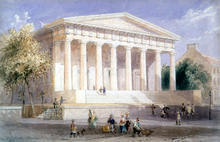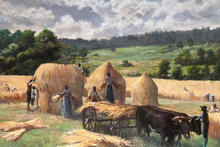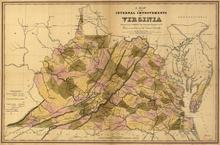Antebellum Virginia’s Evolution in Political Economy
by Ian Iverson
Antebellum Virginia’s Evolution in Political Economy
The chartering of the University of Virginia in January 1819 coincided with the first national peacetime economic depression in American history. The Panic of 1819, precipitated by a market correction in post-Napoleonic Europe and the inflationary policies of the Second Bank of the United States (BUS), hit the Old Dominion particularly hard. As the BUS implemented a draconian policy of fiscal curtailment, the price of tobacco, Virginia’s major cash crop, plummeted, subjecting farmers and planters throughout the state to several years of severe privation. A slow recovery began in 1823, but Thomas Jefferson’s dream of a commonwealth insulated by an independent yeomanry had been shattered. Virginians had entered into an age of modern commercial agriculture.1
The following decades saw a major economic transformation which accompanied the state’s shifting demographics. Some Eastern planters left for the burgeoning Cotton Kingdom of the Southwest while others shifted production from away from tobacco in favor of wheat, vegetables, and swine. Two centuries of relentless tobacco cultivation had sapped the Old Dominion’s soil of many essential nutrients and it would take nearly three decades of inadvertent crop rotation to recover enough nitrogen to productively produce the world’s favorite source of nicotine. A few prescient planters, such as the Fire-Eater Edmund Ruffin, anticipated the discoveries of modern agricultural science and advocated for systematic reforms through organizations such as Albemarle Agricultural Society. Most Virginians, however, satisfied themselves with minor adjustments rather than adopting the compressive program advocated by reformers.2
By both explicit and implicit actions, many middle-class champions of agricultural reform linked their cause to the general promotion of public education. Unlike many Northern states, Virginia lacked a system of tax-funded public schools and with the exception of elite-dominated UVA relied exclusively on private academies and colleges for the education the Old Dominion’s youth.3 Reformers found opponents on both extremes of the socio-economic spectrum. Elitist planters, especially in the Tidewater, opposed public education as a matter of principle while self-identified “clodhoppers,” poor farmers in the western half of the state, doubted whether they would benefit from formal education and opposed any increase in their taxes. Thus, ironically, those who had the most to gain from publicly-funded eduction— western yeomen—often joined with their otherwise enemies— the most elitist easterners— to block public school bills in the state assembly.4
The agricultural improvement initiative produced a second dilemma which loomed over planters until the beginning of the Civil War. Large scale agricultural shifts required significant investment. Major Southern banks usually prioritized maintaining specie reserves over extending credit, and Virginia’s bankers proved especially conservative. While the significance of smaller private (unchartered) banks remains a topic of interest among historians, most Virginians struggled to secure the long-term loans necessary for the accumulation of fixed capital.5 As a result, planters began to liquidate their primary fixed assets— the bodies of enslaved people. As recently detailed by the UVA trained historian Calvin Schemerhorn, these Virginian found ready buyers among the slave trading firms which sprang up throughout the Upper South.6 However, these slave sales threatened to undermine the slave system itself in Virginia. Planters thus tread carefully as they sought to navigate the challenges economic modernization without sacrificing their “peculiar” institution.7
With this knowledge, historians have debated the particular dynamics of the relationship between slavery and agricultural modernization. Some, such as Eugene Genovese, have argued that the transition to grain crops, vegetables, and livestock fundamentally undermined the system of slavery. According to his theory of slave management:
To take slaves away from a single money crop a manager would have to divide his attention and supervise several operations simultaneously or to rely on drivers of questionable ability and usefulness. The slaves were quick to take advantage and to work even less energetically and skillfully than usual and planters despaired of making diversification pay.8
While compelling in the abstract, especially given our knowledge of everyday resistance through work slowdowns among the enslaved, Virginia’s agricultural output challenges this hypothesis. As demonstrated in the work of the economic historian Gavin Wright, by the 1850s, the Commonwealth’s largest slaveholders had fully embraced crop diversification. In fact, when given the chance, poor yeomen, and not slaveholding planters, seized the chance to revive tobacco cultivation in the 1850s. Unlike tobacco, which requires intensive-care throughout the growing process, wheat and other grains require only short periods of intensive cultivation for a successful crop. As a result, one might assume that slaveholders would have preferred tobacco to wheat given so as to avoid “wasting” the labor of the enslaved in periods of idleness. In fact, slaveholders used their absolute control of enslaved labor to their advantage at harvest time— achieving a concentration of labor proved competitive with the mechanized production adopted by Northern farmers. Southern yeomen could not afford to hire extra hands during the wheat harvest to achieve the necessary economy of scale and consequently preferred the constant toil of tobacco to the seasonal burst associated with wheat.9
Alongside these agricultural changes, vast improvements in the state’s infrastructure promoted a level of economic integration unimaginable a few decades before. In the decade before the Civil War, the Virginia’s railroads extended from 350 miles of track to nearly 1700 miles. The state’s set of “internal improvements” also included new turnpikes and canals which linked the port of Norfolk to the state’s breadbasket in the Shenandoah Valley via the increasingly industrial towns of Richmond and Petersburg.10
Experiments in light manufacturing, such as those performed by Lynchburg’s tobacconists, provided a model for adopting slavery to the factory system.11 Over time, heavy industries, such as Richmond’s Tredegar Iron Works, took advantage of the local enslaved labor force to expand production and cut costs. Such developments provoked equal doses of excitement and anxiety for the slave owning master class. On the one hand, such adaptions redirected excess slave labor to a productive use which would further diversify Virginia’s economy. By the 1850s, many young Virginians hoped that the Old Dominion might become the South’s dominant manufacturer. Indeed the Civil War, transformed Richmond into both the capital of the Southern Confederacy and its leading industrial city.12 The use of enslaved labor in manufacturing also diminished the appeal of Virginia to European immigrant laborers, a group perceived as a threat to Southern culture by many elite Virginians. Nevertheless, others within the master class worried that such steps towards industrialization would undermine slavery’s social order. Factory work and urban life offered enslaved workers a degree of autonomy foreign to the planation system. Such independence substituted the impersonal “Yankee” model of labor relations for the paternalist model of slave and master championed by Virginians of the late-antebellum period.13
The 1850s proved a period of agricultural reform, infrastructural improvement, and economic expansion for Virginia, even as political conflict roiled the Old Dominion at both the state and national levels. These changes created an aura of uncertainty which many embraced and others denounced. As the commonwealth evolved, clashing visions for Virginia’s future emerged among the state’s political, dividing white Virginians along lines of party, geography, gender, and generation.
1. William G. Shade, Democratizing the Old Dominion: Virginia and the Second Party System, 1824-1861 (Charlottesville: University Press of Virginia, 1996), 30-33.
2. William A. Link, Roots of Secession: Slavery and Politics in Antebellum Virginia (Chapel Hill: The University of North Carolina Press, 2003) ProQuest Ebook Central, 45-56; Eugene D. Genovese, The Political Economy of Slavery: Studies in the Economy and Society of the Slave South, 2nd ed. (Middletown, Ct.: Wesleyan University Press, 1988), ProQuest Ebook Central, 125-127.
3. The Medical College of Virginia, the predecessor of the Virginia Commonwealth University, became a state institution in 1860.
4. William Blair, Virginia’s Private War: Feeding Body and Soul in the Confederacy, 1861-1865 (New York: Oxford University Press, 1998), 27; Shade, Democratizing the Old Dominion, 188-200.
5. Larry Schweikart, “Southern Banks and Economic Growth in the Antebellum Period,” The Journal of Southern History 53 (Feb. 1997), 28-34; Howard Bodenhorn, “Private Banking in Antebellum Virginia: Thomas Branch & Sons of Petersburg,” The Business History Review 71 (Winter 1997), 515-521.
6. Calvin Schemerhorn, The Business of Slavery and the Rise of American Capitalism, 1815-1860 (New Haven: Yale University Press, 2015), 176-179.
7. Genovese, The Political Economy of Slavery, 139.
8. Genovese, The Political Economy of Slavery, 133.
9. Gavin Wright, “Slavery and American Agricultural History,” Agricultural History 77 (Autumn 2003), 541-548.
10. Blair, Virginia’s Private War, 13; Peter S. Carmichael, The Last Generation: Young Virginians in Peace, War, and Reunion (Chapel Hill: University of North Carolina Press, 2005), 247.
11. Stephen Elliot Tripp, Yankee Town, Southern City: Race and Class Relations in Civil War Lynchburg (New York: New York University Press, 1997), EBSCO eBook Collection, 19-21.
12. Carmichael, The Last Generation, 127; Daniel Walker Howe, What Hath God Wrought: The Transformation of America, 1815-1848 (New York, Oxford University Press, 2007), 550-551; Viken Tchakerian, "Productivity, Extent of Markets, and Manufacturing in the Late Antebellum South and Midwest." The Journal of Economic History 54 (Sept.,1994), 516.
13. Genovese, The Political Economy of Slavery, 234-235; Link, Roots of Secession, 82-83.



